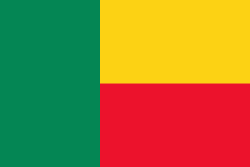Dassa-Zoumè (Commune of Dassa-Zoume)
Dassa-Zoumé, also known as Igbo Idaasha or simply Dassa, is a city in central Benin, on the Cotonou-to-Parakou railway and the main north-south highway. It is the capital of Collines Department. The commune covers an area of 1711 sqkm, and as of 2013 had a population of 112,118.
Jama'at Islamique Ahmadiyya Benin built its central mosque (Mosquée Moubarqiue) here in 2010, which has a tall 18-meter minaret, just outside the city on the main road towards Parakou. Jama'at Islamique Ahmadiyya Benin also built a French/English bilingual primary school here, called Ecole Primaire Publique Ahmadiyya.
The indigenous population of Dassa are the Idaasha. They migrated from the Egba subgroup of western Yoruba in present-day Nigeria to settle here. The city is known as a place of pilgrimage; the Virgin Mary is said to have appeared in the Grotte Notre-Dame d'Arigbo, around which a basilica has since been built containing several shrines. The city is also known for its surrounding forests and hills, many of which contain Voodoo shrines.
Dassa is also home to a Yoruba constituent monarchy.
Jama'at Islamique Ahmadiyya Benin built its central mosque (Mosquée Moubarqiue) here in 2010, which has a tall 18-meter minaret, just outside the city on the main road towards Parakou. Jama'at Islamique Ahmadiyya Benin also built a French/English bilingual primary school here, called Ecole Primaire Publique Ahmadiyya.
The indigenous population of Dassa are the Idaasha. They migrated from the Egba subgroup of western Yoruba in present-day Nigeria to settle here. The city is known as a place of pilgrimage; the Virgin Mary is said to have appeared in the Grotte Notre-Dame d'Arigbo, around which a basilica has since been built containing several shrines. The city is also known for its surrounding forests and hills, many of which contain Voodoo shrines.
Dassa is also home to a Yoruba constituent monarchy.
Map - Dassa-Zoumè (Commune of Dassa-Zoume)
Map
Country - Benin
 |
 |
| Flag of Benin | |
From the 17th to the 19th century, political entities in the area included the Kingdom of Dahomey, the city-state of Porto-Novo, and other states to the north. This region was referred to as the Slave Coast from the early 17th century due to the high number of people who were sold and trafficked during the Atlantic slave trade to the New World. France took over the territory in 1894, incorporating it into French West Africa as French Dahomey. In 1960, Dahomey gained full independence from France. As a sovereign state, Benin has had democratic governments, military coups, and military governments. A self-described Marxist–Leninist state called the People's Republic of Benin existed between 1975 and 1990. In 1991, it was replaced by the multi-party Republic of Benin.
Currency / Language
| ISO | Currency | Symbol | Significant figures |
|---|---|---|---|
| XOF | West African CFA franc | Fr | 0 |
| ISO | Language |
|---|---|
| FR | French language |















